- Submissions

Full Text
Cohesive Journal of Microbiology & Infectious Disease
The Pandemic Outbreak and Mortality Associated with Coronavirus Disease-19 in US and European Countries
Nazish Huma Khan1*, Mohammad Nafees2, Tooba Saeed2, Fazli Zuljalal1 and Ruidar Ali Shah1
1University of Swabi, Pakistan
2University of Peshawar, Pakistan
*Corresponding author: Nazish Huma Khan, University of Swabi, Pakistan
Submission: July 29, 2020; Published: February 05, 2021

ISSN 2594-0190 Volume4 issues5
Abstract
The current pandemic outbreak of SARS-CoV2 has caused a worldwide panic. This dead virus attacked the people of Wuhan China for the first time and then quickly spread all over the world. Now the US and Europe have become the main targeting centers of this virus with thousands of deaths with pneumonia. This review article is aimed to highlight the current pandemic outbreak in the US and European countries, particularly those countries where the situation becomes out of control. For this purpose, the review article summarized the data extracted from various national and international level articles and relevant reports. For data collection, 58 articles/reports were studied. An overview of published articles and relevant reports stated that the trend of confirmed cases reported as USA (3,833,271) followed by Brazil (2,075,246), Russia (765,437), Spain (305,935), UK (294,687), Italy (243,230), Turkey (217,799), Germany (201,931), France (174,674), Switzerland (33,148) and South Korea (13,672). Similarly, the USA is leading to the death rate of 142,877, which is a world record. The speed of the virus is in progress and is spreading to other countries of the world. There is no antiviral vaccine or treatment invented against SARS-CoV2 to control it. To shrink the risk of this viral attack, there is a dire need to develop an effective antiviral vaccine.
Keywords: Europe; SARS-CoV2; Outbreak; Pandemic; Death rate; Confirmed cases
Introduction
The epidemic of novel coronavirus (SARS-CoV2) put human history in a very strange time. The infection of this virus is a respiratory illness in humans. The infection originated in the Wuhan province of China in late 2019. A cluster of pneumonia cases was reported in Wuhan China in December 2019, having symptoms of fever, cough, fatigue and symptoms of gastrointestinal infection in a small population. Soon this infection has grown rapidly, and cases have been reported throughout the world. The novel coronavirus (SARS-CoV2) is entirely new that was identified for the first time in samples of bronchoalveolar lavage fluid (BALF) in a patient in Wuhan, China. It was preceded by MERs-CoV (2012) and SARSCoV (2003). These viruses were investigated to come from animals and are considered more dangerous to humans as they are unknown to the human immune system. The SARS-CoV2 introduced a highly pathogenic, transmittable and large-scale Corona’s epidemic of the 21st century into the human. Therefore, SARS-CoV2 was declared a pandemic by the World Health Organization (WHO 2020). The novel virus was isolated on the 7th of January 2020 and named as Wuhan coronavirus or 2019 novel coronavirus (2019-nCov) by the Chinese researchers. While the World Health Organization officially named it as COVID-19. This new virus has a highly identical genome with a bat coronavirus and belongs to β-coronavirus. It has been considered as the most dangerous type of viruses which is the main cause of human loss. The virus is also resembling SARS-CoV and therefore, is named as SARS-CoV2 by the International Committee on Taxonomy of Viruses. The virus not only cause throat infection, but it completely damages the respiratory system leading to severe pneumonia. The aged and ailing people with chronic lung diseases, heart problem, immunocompromised, severe obesity, diabetes, kidney diseases, and liver diseases are vulnerable to SARS-CoV2. The Wuhan, an emerging business hub of China, experienced an outbreak of a novel coronavirus that killed more than 1800 people and infected over 70,000 individuals within the first 50 days of the epidemic. The virus got a global concern in the month of February 2020, and the infections were continued with a record of 100,000 across the world. The global infections boosted furthermore with 1,919,913 confirmed cases and 119,666 deaths in 211 countries reported by the WHO on the 14th of April 2020. The fraction of undocumented but infectious cases is a critical epidemiological characteristic that modulates the pandemic potential of an emergent respiratory virus. By the 23rd of April, the SARS-CoV2 world record reached to 2,627,630 with 183,336 deaths. For understanding the overall prevalence and pandemic potential of this disease, estimation of the prevalence and contagiousness of undocumented novel coronavirus (SARS-CoV2) infections is critical. Before 23rd January 2020 travel restrictions, it is estimated that 86% of all infections were undocumented, often experience mild, limited or no symptoms which are not recognized and can expose a far greater portion of the population to the virus [1-5]. The SARS-CoV2 affected the performance of China with economic loss. This incident has drawn the world’s attention and become a global concern. After massive efforts of China, the novel virus spread strikingly to all over the world. The infections of SARS-CoV2 were just appeared by the end of January 2020 in Europe. Currently, Europe has become the main center of SARS-CoV2 disease with a record number of infections. A there is no antiviral vaccine discovered against SARS-CoV2 disease, but scientists around the world are in progress to discover its treatment. To decrease the peak infection rate, many countries of the world have taken drastic measures such as implementing travel ban, quarantines, intensified surveillance and social distancing [6-8].
SARS-CoV2 in the United States of America
The situation became critical in the United States, and it is ranked on the top of the list among infected countries. The first case was reported when a 35-year-old man having 4 days history of cough and fever was presented to an urgent care clinic in Snohomish County, Washington, on the 15th of January 2020. The patient was returned from Wuhan, China and was found positive for SARS-CoV2 disease after test results on the 20th of January. However, the patient reported that he has not visited the seafood market, or hospital or had any sick contact during Wuhan’s stay. The patient was admitted to an airborne-isolation unit at Providence Regional Medical Center for clinical observation. The second case in the US was reported on the 24th of January. It was reported that SARS-CoV2 virus has spread between two people in the United States, representing the first instance of person-to-person transmission on the 30th of January 2020 (CDC, 2020). By the end of February 2020, a total of 12 cases were confirmed with positive results of SARS-CoV2 disease. All these patients have traveled history. The first confirmed death in the US was reported on the 1st of March in Washington state. Since the 16th of March onward, a drastic increase in the new cases begun. In comparison, a huge range of increase in mortality was reported by the 25th of March and onward @54,916 confirmed cases and 784 deaths. After a few days, the number of infections reached the world record as 142,537 total reported cases and 2,510 deaths by 29th of March. The US president called an emergency against the SARS-CoV2 outbreak at the national level.
The SARS-CoV2 disease has infected every age of the population in the United States. On 7th of April 2020, the country is in the acceleration phase of the pandemic and all the 50 states have reported cases of SARS-CoV2. The test results reported 586,057 with 23,604 deaths (Figure 1). Based on death certificate data, the percentage of deaths attributed to SARS-CoV2 increased from 4.0% during week 13 to 6.9% during week 14 (COVID View, 2020). By the end of April, the confirmed cases were 920,703 with 50,641 deaths. Currently (28, May), the number of infections extended to 1,745,803 with 102,107 deaths. The US government announced 50 US billion dollars to combat this deadly virus. They increased the progress of diagnostic labs for their quick response to know the situation and try to tackle the disease [9-15].
Figure 1: SARS-CoV2 in US.
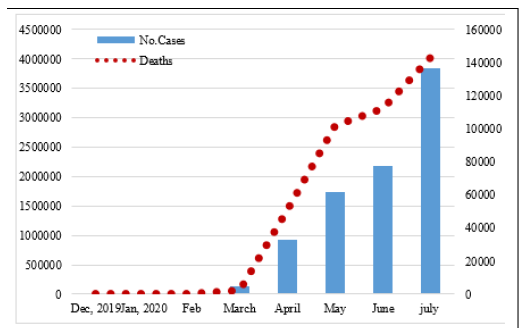
SARS-CoV2 Across Europe
After Pandemic of SARS-CoV2 infection in China, large epidemics of this disease have emerged in Europe. The epidemic began slightly later in Europe. In European countries, the first case was detected in South Korea on the 19th of January 2020. The number of deaths and confirmed cases was higher in China and other countries of the world. The WHO declared Europe as the active center of SARS-CoV2 pandemics by the 13th of March 2020. The number of confirmed cases by the countries across Europe became doubled over a for typically 3-4 days. As of the 17th of March, every country of Europe reported deaths with a total of 2740 due to SARS-CoV2 disease. More than 250 million people were lockdown in Europe by the 18th of March 2020. The number of infected populations reached 43 million (representing 11.43% of the population) by the end of March. The rate of infected and deaths rate found highest in Spain followed by France, Italy, Germany, Turkey, Switzerland, and Netherland. Currently, Spain has been observed for an increasing number of SARS-CoV2 infections with a population of 7 million (15% of the population) deaths. In Italy, round about 5.9 million people (9.8% of the population) have been end of March. The severity of SARS-CoV2 found low in South Korea, Norway, Scotland etc. The impact of SARS-CoV2 is relatively low in all those countries who adopted the early intervention. But the ups and downs can be possible in the infection rate of the countries around the world (Flaxman et al, 2020). In Europe, Germany, France, Italy, and the UK are the network hub and remained as the most hit nations due to SARS-CoV2. Therefore, thy supply-chain contagion is the major source of economic downfall in Europe. Throughout the world, Europe is currently the most affected site regarding SARS-CoV2 infections and deaths (Figure 2). The health care systems of the European countries are under extreme pressure. A combination of the preventive measure was adopted by countries to get control over SARS-CoV2. Most of the interventions adopted around 12-14 March. The number of deaths reported as 59,000 around European countries till the 31st of March. In such a panic situation, the European countries implemented community isolation measures preferring social distancing, imposing work restrictions and closing public places and shops. This speedily spreading virus imposed a remarkable burden on the economic system of the European countries. The literature revealed that the death risk of SARS-CoV2 for people with age <65 years may affect the feasibility of different management strategies for the pandemic [15-21]. People having less than 65-year age are considered as the “lion’s share” of the workforce. The SARS-CoV2 attack hacked the entire economy into a tailspin. All the sectors such as manufacturing, tourism, education, marketing and healthcare are in a shock state. This ripple effect through tightly coupled industries is producing a progressive decline in stock values, pushing the European economy towards recession. This lead to affect the social lives of people. To handle the panic situation and reduce the risk, European countries, in particular, are struggling for the production of vaccines. For example, the USA defined $3 billion for vaccine preparation [22-30].
Figure 2: SARS-CoV2 across the Europe.
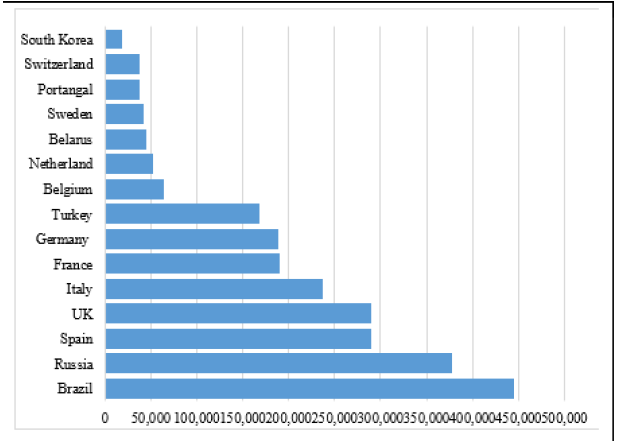
Source: official daily statistics from Minister of Health.
SARS-CoV2 in Spain
The first SARS-CoV2 confirmed case was reported in Spain on the 31st of January 2020. This patient was infected due to close contact with an infected person. After that, multiple cases were reported in February 2020, including a medical doctor. The disease speeds up in March with thousands of confirmed cases. An enormous increase in the new cases and deaths began on March 9 and 12, 2020, respectively. The Government imposed a nationwide quarantine and banned all trips by the 14th of March. 2020. The number of cases reported as 94417 confirmed and 8,189 deaths by March. To reduce the risk, the Government tightened the national level lockdown due to which 900,000 workers lost their jobs. The Prime Minister of Spain announced a support package of more than 200 billion euros, almost 20% of the Spanish GDP to cushion the impact of the coronavirus crisis. In April, the diseases spread to 213,435 cases and 24543 deaths. The pandemic is in progress towards increase. The infection rate was reported as 236,769 with 27118 deaths by the end of May. Till now, the number of confirmed cases is reported as 305,935 with 28416 deaths by mid of July 2020 (Figure 3); [31-45].
Figure 3: SARS-CoV2 in Spain.

Source: world meter Corona.
SARS-CoV2 in Italy
The disease of SARS-CoV2 spread in Italy in late January 2020. Italy was the 3rd targeting country of SARS-CoV2 infection after China and Iran pandemic. The first 2 cases in Italy were reported on the 31st of January when two Chinese arrived from China on the 23rd of January 2020. They travelled on a tourist bus and were reported positive for SARS-CoV2 disease. Later on, another case was reported on the 6th of February in an Italian inhabitant who returned from Wuhan China. The process continued, and the number of infected persons was increased to 60 by the 22nd of February. The outbreak was implemented in Italy, but the diseases spread with a striking speed to other European countries. Amongst the European countries, Italy was the first and more affected country with the highest number of infections and deaths, and the Government imposed strict community isolation measures by the 9th of March 2020. The number shot up in March 2020, and cases increased to an enormous number of 31,506 with 2503 deaths on the 17th of March. Italy reported a record number of deaths as 368 in 24 hours. The record of death rate in Italy @ 2978 by the 18th of March, has reached to the whole number of deaths in China (3245). The death rate was common in persons having a weak immune system, including 70 plus age and patients of cancer, heart, and diabetes. To reduce this risk, the Government of Italy imposed extraordinary preventive measures. Although their preventive efforts were outstanding, the percentage of newly infected cases in the ICUs was more than 11% on a daily basis, and still, the situation is getting worse day by day. The number of infections recorded as 211,938 with 29,079 deaths in April and 231,139 with 33,027 deaths by the end of May. The current active cases are 243,230 with 34,967 deaths by mid of July 2020 (Figure 4); [45-49]. The pandemic of SARS-CoV2 in Italy showed that how speedily the healthcare system can be overwhelmed. Many patients are in a critical state that requires intensive care, and the situation is getting worse day by day.
Figure 4: SARS-CoV2 in Italy.
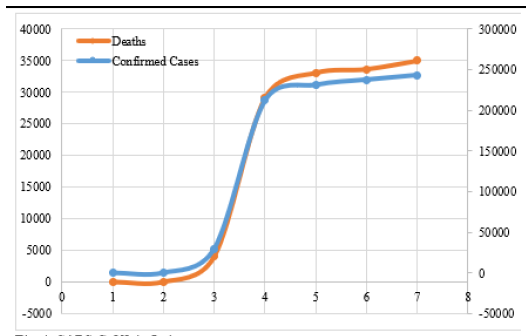
Source: world meter Corona.
SARS-CoV2 in France
The disease SARS-CoV2 started in China by December 2019, and it spread around the world reaching the pandemic stage on the 11th of March 2020. In Franc, the first case was detected on the 24th of January 2020 in a 48 year old French citizen who traveled from China. Similarly, another couple was also diagnosed positive for SARS-CoV2 disease in Paris who returned from China. The first five cases were reported in all those individuals who had traveled from China. The individual of the first death of SARS-CoV2 was a Chinese tourist reported in France on the 14th of February 2020. France has been considered on number 4th as the most affected European country. Due to a smaller number of screening tests in the country, data about actual infected people is not known, and this number is much higher than cases under observation. An important key route of SARS-CoV2 across France was the event of the annual assembly of the Christian Open-Door Church. This event was attended by approximately 2500 people, and at least half of them were believed to have contracted the disease. The people in France did not take preventive measures at the start. The Government declared lockdown in the country on the 17th of March 2020, but the SARSCoV2 disease has spread all over the country. On the 14th of March, the number of confirmed cases reached to 4,499 with 91 deaths. By the 30th of March 2020, the number shot up with a record of 418 deaths in 24 hours. In April, the number of infections increased to 174,791 with 25986 losses. The cases reported as to 182,427 with 28,596 deaths by the end of May. Now the number of confirmed cases is reduced, and the new cases reported as 174,674 with 30152 deaths by mid of July 2020 (Figure 5); [49-55].
Figure 5: SARS-CoV2 in France.
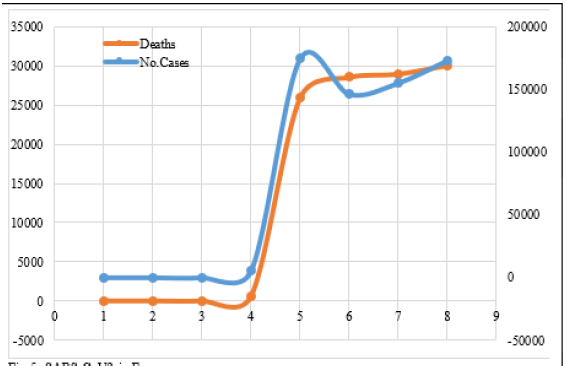
Source: official daily statistics from Minister of Health.
SARS-CoV2 in the United Kingdom
In the United Kingdom, the ongoing pandemic SARS-CoV2 reached in early 2020. The first 2 cases were reported on the 28th of January 2020. The first patient was a 50-year-old lady who traveled from Hubei China on the 23rd of January 2020. She was reported with fever and malaise on the 26th of January. The second patient was a resident of the UK (23-years old male) diagnosed with the symptoms of fever, which lead to dry cough and diffused myalgia on the 28th of January. He had also traveled from Hubei China on the 6th of January 2020. Both patients were admitted in the hospital and were kept under treatment. The new cases of human-to-human transmission SARS-CoV2 were reported in England by the 9th of February 2020. In contrast, an enormous increase in SARS-CoV2 infections was observed in the month of March 2020. On the 1st of March, the confirmed cases were reported as 36 while in the mid of the month (the 14th of March) the number raised to 797 with 10 deaths. The number increased to 1500 infections and 55 deaths by the 16th of March. While on the 24th of March, a record of 87 deaths was reported in 24 hours, bringing the total number of deaths to 422. Therefore, the Government declared a complete lockdown and all the information was communicated through media to the people about the current pandemic. This viral infection has the potential to result in a synchronized epidemic that peaks at around four months. It depends on the seasonal transmission and personto- person transmission that even a small change in any one factor can affect a big change in the transmission risk of viruses. Later on, the Prime Minister of the UK Boris Johnson was also found infected after positive test results of SARS-CoV2 on the 5th of April 2020. He had been admitted to ICU when the symptoms further worsened. The Prime Minister has recovered and left the hospital on the 11th of April 2020. The number of infections further increased in April and reached the world record. In April, the number of infected cases reached to 206,715 with 30,615 deaths. The severity of disease confirmed the total cases as 267240 and 37,460 deaths on the 28th of May. Currently, the figure changed to 294687 infections with 45,317 deaths (Figure 6). The UK has a limited number of hospital beds per 1000 people. Medical staff have reported for a severe shortage of personal protective equipment and accessories. The Government has made several efforts to cover all the deficiencies and get control over the pandemic.
Figure 6: SARS-CoV2 in Brazil, UK, Russia and Turkey.
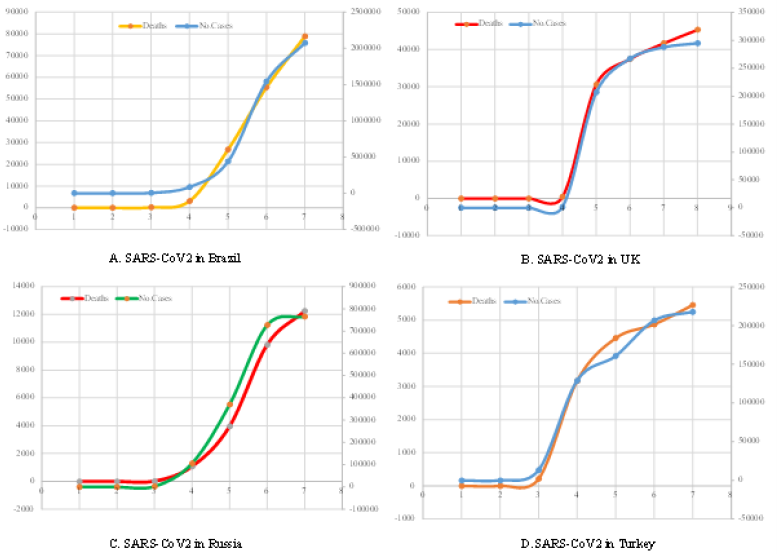
Source: world meter.
Russia
Russia remained safe in the starting 3 months of SARS-CoV2 pandemic. It was relatively late in suffering a serious outbreak. The first case was reported on the 2nd of March. The number of infections was reported as 2337 with 17 deaths by the end of March. The source of SARS-2 disease was Chinese and Italian tourists. The Government banned all the events and imposed lockdown in the country. Other preventive measures were implemented by the Government to restraint the disease. Quarantines, social distancing, carrying busts on potential virus carriers and facial recognition used to impose quarantine measures. In April, the number of confirmed cases reached to 106,498 with 1073 deaths. The severity was observed during May with record infections of 370,680 that makes Russia on top of the worst-hit country of Europe (WHO). Total teste performed were 9.4 million. The number of confirmed cases is 765,537 with 12,247 deaths by mid of July 2020 (Figure 6). Moscow city is the most affected federal subject.
Brazil
The pandemic of SARS-CoV2 reached in Brazil by the end of February. The first confirmed case of SARS-CoV2 was reported on the 26th of February. The severity increased in March with a record of 2.9% mortality and 3904 confirmed cases. Most infections (90%) were observed in 60+ years of age, and most were men. About 84% of deaths were observed in patients having heart, diabetic and respiratory problems. Brazil received the highest number of cases by the 10th of March in Latin America. Due to the panic situation, the country imposed a partial lockdown in March. The number of infections reported as 5,933 with 206 deaths by the end of March. Sao Paulo is the most affected state followed by Rio de Janerio in the number of infections and deaths. In April, Brazil crossed the record of China with 87000 confirmed cases. It is estimated that about 54.8% of all imported cases have been received from travelers came from Italy. While 9.3% of infections came from China and 8.3% received from France. The number increased exponentially fast with a record of 438,238 causing 26764 human losses, making Brazil as the 1st highest number of SARS-CoV2 infections in Europe in May 2020. This record is still in progress with 207546 confirmed cases and 78817 deaths by mid of July (Figure 6). The healthcare system of the country is already fragile as the patients need extra care and intensive care units to be treated.
Turkey
The disease of SARS-CoV2 reached Turkey on the 11th of March with confirmation of the first case in a patient returned from Europe. The first death due to SARS-CoV2 disease was reported on the 15th of March. By the end of March, 13531 cases were reported with 214 losses. After that, the pandemic of SARS-CoV2 became a part of the ongoing worldwide pandemic in Turkey. By April, it was confirmed that the disease has spread all over the country. The number of infections was recorded as 120,204 with 3,174 deaths during April. The severity of disease was reported as 160,979 infections with 4461 deaths by the end of May. The fresh record of confirmed cases is 2,17,799 with 5,458 deaths (July 19-2020), shown in Fig-6. The rapid increase of infections in Turkey did not affect its healthcare system due to the availability of a high number of intensive care units in the country. In comparison, the fear of this pandemic put psychological impacts on human mental health in the country.
SARS-CoV2 in Germany
Figure 7: SARS-CoV2 in Germany.
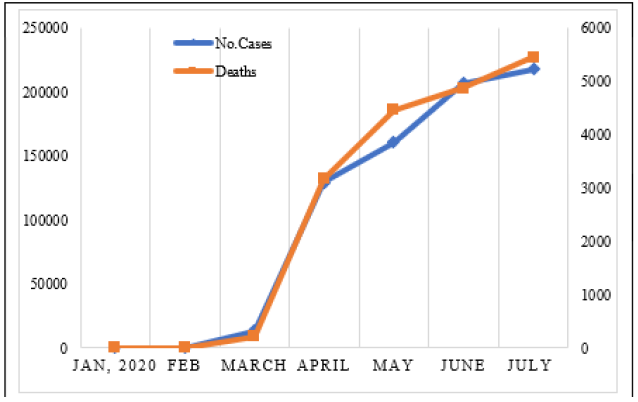
Source: world meter Corona.
The SARS-CoV2 pandemic started in Germany by the end of January 2020. The state of Germany was informed of the first case in a person from Shanghai China working in a company in the greater Munich area. Before visiting Germany, the person had contacted his parents from Wuhan China on the 16th of January. Both parents had cold a week before, and the person visited Germany on the 19th of January 2020 to attend meetings in the company. After a day (the 20th of January), the person felt chest and backaches, and the symptoms changed into fatigue and fever later on. The person visited a general physician, and the test results found positive for SARS-CoV2 on the 26th of January. The patient was hospitalized for treatment. After the first case, the person-to-person transmission SARS-CoV2 infection was reported in16 other employees of the same company by the 11th of February 2020. The employees were ordered to stay at home for 14 days of quarantine. During this period, the health status of employees was monitored regularly. By the end of February, new cases were introduced due to passengers traveling from Italy, Iran and China. At the start of March, multiple cases were reported with a first death due to SARS-CoV2 infection on the 9th of March 2020. To control the pandemic, the Government ordered for complete lockdown on the 22nd of March and forced the people to follow the guidelines as preventive measures. But this human-to-human transmission infection spread so quickly that thousands of people are at risk and the number of infections reached to >10000 by the 30th of March 2020. In April, the infected people were 169,430 with 7392 losses that make Germany as the worst-hit country of Europe. The mortality rate was found high in younger people. Thomas Schafer, the finance minister, committed suicide due to the bad economic situation of the country during this pandemic. By the end of May, 182,403 infections were recorded with 8529 deaths and the number reached to 201,931 cases with 9,082 deaths by mid of July shown in Figure 7.
SARS-CoV2 in Switzerland and South Korea
Due to the current SARS-CoV2 attack, Switzerland remained in the list of top infected countries with a higher number of cases per day. The pandemic of SARS-CoV2 has spread to Switzerland by the end of February 2020. The first case was reported on the 25th of February in a 70 year old man who returned from Italy. By March 2020, the number of patients was confirmed as 2772 with 21 deaths. The virus is spreading speedily through the Swiss population. To fight against this new virus, the Government of Switzerland imposed a complete lockdown on the 16th of March 2020. The overall fraction of infection due to SARS-CoV2 is unclear, but it is estimated that SARS-CoV2 can infect 40-70% of people with severe illness and deaths in the country, which can affect the healthcare system. Therefore, the Government implemented social distancing and other preventive measures and announced economic support measures worth 40 billion Swiss francs. Total infections of SARS-CoV2 in Switzerland is 16176 (433 deaths) in March, 29586 (1737 deaths) in April and 30,776 (1917 deaths) by the end of May 2020. Recently, the infection rate is reported as 33,148 with 1,968 deaths by mid of July (Figure 8). South Korea reported the first case of SARS-CoV2 on the 23rd of January in a tourist from China. Due to high social interaction inside the country, the number of cases peaked to 909 as per day by the end of February. South Korea reported 10,635 with 7,829 recoveries and 230 deaths only (Fig- 8). In the start, South Korea was on number second due to SARSCoV2 infection. South Korea, in particular, has imposed a complete lockdown at the start. Soon the country got control over SARS-CoV2 and went below the top 20 with a flattened cure of infection growth. The country adopted preventive measures of social distancing and self-isolation measures and implemented strictly throughout the state. The control strategy has reduced the SARS-CoV2 epidemic in the country and the number of cases reduced to 84 by the 17th of March 2020 (Marcel et al., 2020). In April, the number of infections reached 10,774 confirmed cases with 284 deaths. By the end of May, the number of infections reached to 11,344 with 269 deaths. The updated record (the 19th of July 2020) of SARS-CoV2 infections in the country is 13,672 confirmed cases with 293 deaths (Figure 8). The country has the lowest deaths record due to time control measures.
How to Turn Towards the Normal Life?
The future of SARS-CoV2 pandemic is in our hands. As the disease is lacking the specific vaccine and the only way for prevention is based on the new concept of individual hygiene and social distancing. The background history of the mentioned case studies confirmed that SARS-CoV2 spread through direct or indirect contact of human-to-human transmission. Therefore, social cut off and self-isolation is the solution to this deadly virus. By adopting these measures, the Government of China appeared effective in controlling the epidemic. The option is also in practice in South Korea, Germany and other European countries showing little infections with the preservation of health care systems. The outcome of this pandemic is unknown and still, the exact time for vaccine preparation is also unknown. In the meantime, we need to follow preventive guidelines and conduct research and development. As modern wars are against infectious diseases; therefore, preventive measures can change our life, and like China, we can turn towards a normal life because our destiny is in our hands.
Conclusion
The SARS-CoV2 is a pandemic around the world with a record of about 13,280,066 infections and 576,675 deaths in a few months. Nowadays, the people of the USA and Europe are at the highest risk with SARS-CoV2 infection. Starting from Italy, the fatal disease quickly spread to all European countries. In European countries, older people are almost targeted by SARS-CoV2 diseases while in the USA, people of every age group are at risk. Based upon the infections, the USA has been reported on the top list across the world-leading by the European countries. Efforts are still underway all around the world. Due to limited pharmaceutical measures, the only way to return to normal life is to keep social distancing and self-isolation. To block the person-to-person transmission, it is important to find effective antiviral treatments for severely infected people.
Acknowledgement
The authors are thankful to the University of Swabi for providing the opportunity to work on the present pandemic of SARS-CoV2.
References
- Anderson RM, Heesterbeek, Klinkenberg (2020) How will country-based mitigation measures 453 influence the course of the COVID-19 epidemic? Lancet 395(10228): 931-934.
- Bernard S (2020) First cases of coronavirus disease 2019 (COVID-19) in France: surveillance, investigations and control measures, January 2020. Euro Surveill 25(6): 2000094.
- Bohmer MM, Buchholz VM, Corman, Hoch, Katz, et al. (2020) Outbreak of COVID-19 in Germany resulting from a single travel-associated primary case.
- Candido DDS, Watts A, Abade, Kraemer, Pybus, et al. (2020) Routes for COVID-19 importation in Brazil. Journal of Travel Medicine 27(3): 1-3.
- https://www.cdc.gov/media/releases/2020/p0130-coronavirus-spread.html
- https://www.cdc.gov/coronavirus/2019-ncov/need-extra-precautions/groups-at-higher-risk.html
- https://www.cdc.gov/coronavirus/2019-nCoV/infection-control.html
- https://www.reuters.com/article/us-health-coronavirus-spain-aid/spain-approves-200-billion-euro-aid-package-for-coronavirus-crisis-pm-idUSKBN2142Q4
- https://en.wikipedia.org/w/index.php
- Croda J, Oliveira, Frutuoso, Mandetta, Brito S, et al. (2020) COVID-19 in Brazil: advantages of a socialized unified health system and preparation to contain cases. Journal of the Brazilian Society of Tropical Medicine 53: 167.
- Crokidakis N (2020) Modeling the early evolution of the COVID-19 in Brazil: results from a Susceptible-Infectious-Quarantined-Recovered (SIQR) model. International Journal of Modern Physics 1: 10.
- Cui J, Li, Shi (2019) Origin and evolution of pathogenic coronaviruses. Nat Rev Microbiol 17(3): 181-192.
- https://www.statista.com/statistics/1109308/cumulative-coronavirus-cases-deaths-and-recoveries-in-spain/
- Danon L, Brooks P, Bailey, Keeling (2020) A spatial model of CoVID-19 transmission in England and Wales: early spread and peak timing. BMJ, pp. 1-10.
- Dehkordi AH, Alizadeh, Derakhshan, Babazadeh, Jahandideh (2020) Understanding epidemic data and statistics: a case study of COVID-19 A. JMV 92(7): 868-882.
- Demirbilek Y, Pehlivanturk, Ozguler, Meşe (2020) COVID-19 outbreak control, example of ministry of health of Turkey. Turk J Med Sci 50: 489-494.
- Dong E, Du, Gardner (2020) An interactive web-based dashboard to track COVID-19 in real time. 446 Lancet Infect Dis 20(5): 533-534.
- Du Z, Wang L, Cauchemez S, Xu, Wang BJ (2020) Risk for transportation of 2019 novel coronavirus disease from Wuhan to other cities in China. Emerg Infect Dis 26(5): 1049-1052.
- Ferguson NM, Laydon D, Nedjati G, Imai N, Ainslie K, et al. (2020) Impact of non-pharmaceutical interventions (NPIs) to reduce COVID-19 mortality and healthcare demand. Imperial College, London, UK.
- Flaxman S, Mishra, Gandy, Juliette, Unwin, et al. (2020) Estimating the number of infections and the impact of non-pharmaceutical interventions on COVID-19 in 11 European countries. Imperial College COVID-19 Response Team, pp. 1-35.
- Frederik V, Elise K, Philippe B (2020) Indications for healthcare surge capacity in European countries facing an exponential increase in coronavirus disease (COVID-19) cases, March 2020. Euro Surveill 25(13): 2000323.
- French, Martin, Monahan (2020) Dis-ease surveillance: how might surveillance studies address COVID-19? Surveillance & Society 18(1): 1-11.
- Giselda V, Philip (2020) Pope tests negative for coronavirus, Italy report says. Reuters.
- Guo Y, Cao, Hong, Tan, Chen, et al. (2020) The origin, transmission and clinical therapies on coronavirus disease 2019 (COVID-19) outbreak-an update on the status. Military Medical Research 7: 11.
- https://www.businessinsider.com/coronavirus-treatment-medical-bill-hospital-costs-2020-3
- Hunter DJ (2020) Covid-19 and the stiff upper lip-the pandemic response in the United Kingdom. N Eng Med 382(16): 1-3.
- Chan, Yuan, Kok, Chu, Yang, et al. (2020) A familial cluster of pneumonia associated with the 2019 novel coronavirus indicating person-to-person transmission: A study of a family cluster. Lancet 395: 514-523.
- John PAC, Axfors G, Contopoulos I (2020) Population-level COVID-19 mortality risk for non-elderly individuals overall and for non-elderly individuals without underlying diseases in pandemic epicenters. Environ Res 188: 109890.
- Lai CC, Shih, Ko, Tang, Hsueh (2020) Severe acute respiratory syndrome coronavirus 2 (SARS-CoV-2) and corona virus disease-2019 (COVID- the epidemic and the challenges. Int J Antimicrob Agents 55(3): 105924.
- https://www.theguardian.com/world/2020/mar/09/how-did-china-get-grips-with-coronavirus
- Marcel S, Christian, Richard, Silvia, Emma, et al. (2020) COVID-19 epidemic in Switzerland: on the importance of testing, contact tracing and isolation. Swiss Med Wkly 19: 150.
- Meier K, Glatz, Guijt, Piccininni, Meulen K, et al. (2020) Public perspectives on social distancing and other protective 1 measure in Europe: a cross-sectional survey study during the COVID-19 pandemic. BMJ, pp. 1-23.
- Michelle L, Holshue C, Bolt S, Lindquist, Wiesman J, et al. (2020) First case of 2019 novel coronavirus in the United States. N Engl J Med 382(10): 929-936.
- Moatti JP (2020) The French response to COVID-19: intrinsic difficulties at the interface of science, public health, and polic. Lancet Public Health 5(5): 255.
- Moss P, Barlow N, Easom, Lillie, Samson (2020) Lessons for managing high-consequence infections from first COVID-19 cases in the UK. Lancet 395(10227): 46
- Nadeem S (2020) Coronavirus COVID-19. J Ong Chem Res 5(1): 7-13.
- Nishiura H, Natalie, Lintona, Andrei RA (2020) Serial interval of novel coronavirus (COVID-19) infections. Int J Infect Dis 93: 284-286.
- Parodi SM, Liu (2020) From containment to mitigation of COVID-19 in the US. JAMA 323(15): 1441-1442.
- Remuzzi A, Remuzzi (2020) Health policy Covid-19 and Italy: what next? Lancet 2: 10-13.
- Rodrigues JCL, Hare, Edey, Devaraj, Jacob, et al. (2020) An update on COVID-19 for the radiologist a British society of thoracic imaging statement. Clin Radiol 75(5): 323-325.
- Rodriguez MAJ, Gallego V, Escalera A, Méndez L, Zambrano C, et al. (2020) COVID-19 in latin America: The implications of the first confirmed case in Brazil. Travel Med Infect Dis 35: 101613.
- Roland K, Markus M (2020) COVID-19 pandemic: palliative care for elderly and frail patients at home and in residential and nursing homes. Swiss Medical Weekly 150: 20235.
- Roques L, Klein, Papa, Sar, Soubeyrand (2020) Using early data to estimate the actual infection fatality ratio from COVID-19 in France. pp:1-8.
- Rowena M (2020) Boris Johnson leaves hospital as he continues recovery from coronavirus. Guardian.
- Ruiyun L, Pei, Chen, Song, Zhang, et al. (2020) Substantial undocumented infection facilitates the rapid dissemination of novel coronavirus (SARS-CoV2). Science 368(6490): 489-493.
- Satici B, Gocet T, Deniz, Satici (2020) Adaptation of the fear of COVID-19 scale: its association with psychological distress and life satisfaction in turkey. International Journal of Mental Health and Addiction. Pp. 1-9.
- https://www.npr.org/sections/health-shots/2020/03/06/812964894/where-that-8-3-billion-in-u-s-coronavirusfunding-vwill-and-wont-go.
- https://ssrn.com/abstract=3566689
- Shereen MA, Khan, Kazmi, Bashir (2020) COVID-19 infection: origin, transmission, and characteristics of human. Coronaviruses. J Adv Res 24(1): 91-98
- Munster, Koopmans, Doremalen, Van Riel (2020) A novel coronavirus emerging in China Key questions for impact assessment. N Engl J Med 382(8): 692-694.
- Wang N, Shi X, Jiang L, Zhang S, Wang D, et al. (2013) Structure of MERS-CoV spike receptor-binding domain complexed with human receptor DPP4. Cell Res 23(8): 986-993.
- Coronavirus disease.
- Won So (2020) Coronavirus (COVID-19) in South Korea statistics & facts.
- Wycliffe EW, Li, Chiew, Yong, Toh (2020) Presymptomatic Transmission of SARS-CoV-2- Singapore. MMWR Morb Mortal Wkly Rep 69(14): 411-415.
- Zhong N, Zheng, Li, Poon, Xie, Chan (2003) Epidemiology and cause of severe acute respiratory syndrome (SARS) in guangdong, people’s republic of China. Lancet. 362(9393): 1353-1358.
© 2021 Vikrant Minhas. This is an open access article distributed under the terms of the Creative Commons Attribution License , which permits unrestricted use, distribution, and build upon your work non-commercially.
 a Creative Commons Attribution 4.0 International License. Based on a work at www.crimsonpublishers.com.
Best viewed in
a Creative Commons Attribution 4.0 International License. Based on a work at www.crimsonpublishers.com.
Best viewed in 







.jpg)






























 Editorial Board Registrations
Editorial Board Registrations Submit your Article
Submit your Article Refer a Friend
Refer a Friend Advertise With Us
Advertise With Us
.jpg)






.jpg)













.bmp)
.jpg)
.png)
.jpg)














.png)

.png)



.png)






